WHAT TO DO WHEN CONSTIPATED ON THE TOILET - 6 STEPS
- Medically reviewed by: Horia Marculescu, MD
- Photo credits: Licenses / Author
- Last updated: 01.03.2024
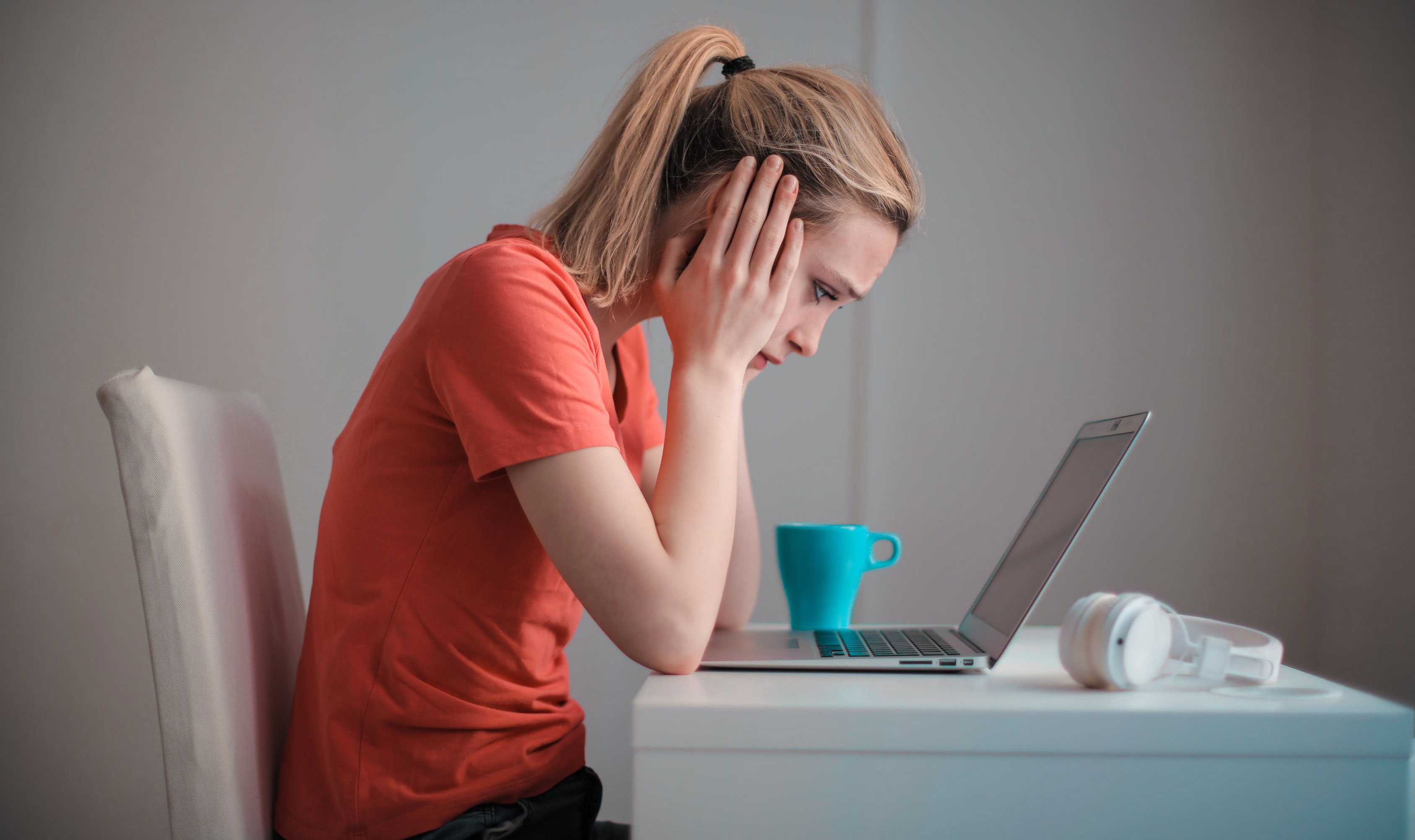
What to do when constipated on the toilet? Here are six steps that help stool evacuation:
- Prepare your body to relax completely.
- Clean the toilet bowl with anti-bacterial soap.
- Place a low-rise footstool.
- Adopt the squat posture.
- Squeeze the abdomen.
- Squeeze the rectum and push.
- Take a pause and relax.
When you feel the stool ready to evacuate, proceed with gentle caution. The result should come naturally.
Follow the steps and learn to prepare your body for smooth defecation. Also, you will know about other techniques that help bowel movement.
1. PREPARE YOUR BODY FIRST
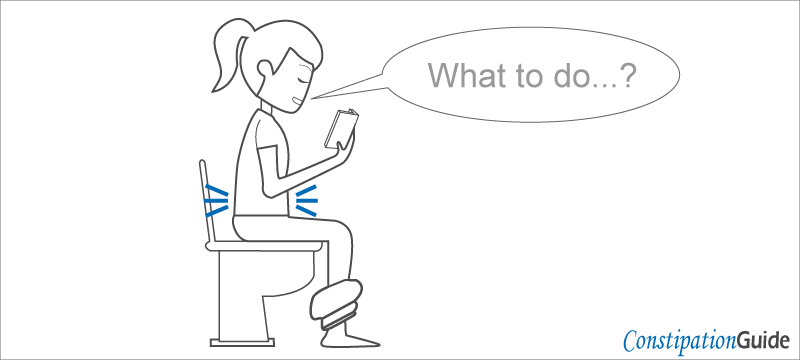
The first step on what to do when constipated on the toilet is to prepare your body.
Smooth defecation comes after:
- Relaxing your puborectalis muscles;
- Relaxing the anal sphincter;
- Relaxing your body.
Preparing your body and mind before going to the toilet is a great technique to improve digestion.
Preparation is everything before going to the toilet with constipation.
This thing means to relax your body and to relax even more your bottom part. A tired body can’t handle proper digestion and bowel movement.
Use the squat posture to relax your body.
Squat to relax your body as follows:
- Lower your body in the squat position.
- Stay there for 30-60 seconds.
- Lift your body.
- Stay there for 30 seconds.
- Start all over 5-10 times.
This technique is excellent for preparation. It relaxes the lower part of your body and expands the intestines.
The Squat or the Semi-Squat posture are excellent positions that release puborectalis muscle tension.
These simple steps might be hard to do at first, but they will help you to relax your body. You can practice them when taking a break from work or study.
Get rid of negative emotions and stress.
Negative emotions slow down digestion and stool evacuation. Our primitive instinct appears whenever we deal with stress or negative situations.
Due to this fact, digestion slows down, and our body sends all the resources to
- the heart;
- lungs;
Stress influences these vitals every time we are in a difficult situation.
Long periods of stress combined with a diet low in nutrients and fiber are a cause of episodic constipation among adults and older people.
As reported by The World Journal of Gastroenterology:
“ Biopsychosocial risk factors such as psychological stress, poor dietary habits, obesity, and child maltreatment are commonly identified predisposing factors for Functional Constipation.”
Get hydrated.
Drinking mineral water is an excellent thing to do when constipated on the toilet.
Dehydration is another cause of constipation, especially in adults.
Long periods of dehydration have only undesirable effects on digestion and bowel movement.
Before going to the toilet, drink one glass of non-carbonated mineral water.
In this way, your body will know that you are ready to poop and will have enough water to keep the intestines hydrated.
According to The National Institute of Diabetes and Digestive and Kidney Diseases:
“Drinking enough water and other liquids is also an excellent way to avoid dehydration.”
According to the same health authority:
“Try to relax your muscles. Or put your feet on a footstool to make yourself more comfortable.”
Also, be patient and give yourself enough time until you have a bowel movement. When this thing happens, go immediately to the toilet.
2. CLEAN THE TOILET BOWL
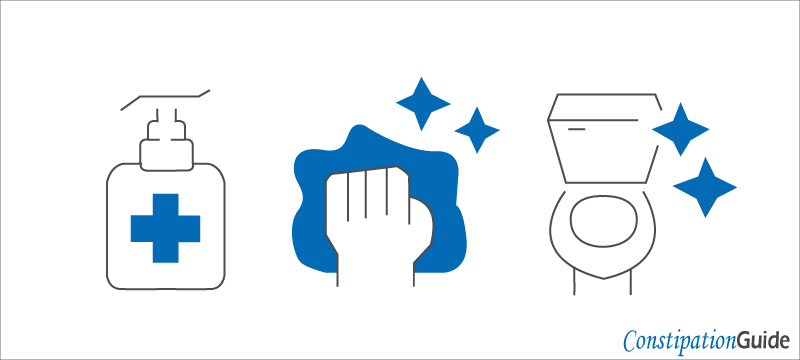
Our body puts pressure on our nervous system when we see a dirty toilet bowl,
This thing makes us anxious, constipated, and tense.
So, here’s what to do when constipated on the toilet with Step 2.
Use anti-bacterial liquids to clean the toilet bowl.
Before you clean the toilet, get a sponge for the toilet bowl and one for the toilet seat.
Viruses and bacteria can be present in the toilet bowl.
If you work in a dirty environment or have pets at home, this thing might be a problem.
A clean toilet relaxes our body and mind. A clear mind will help to have proper stool evacuation.
Here are a few steps to follow:
- Clean your toilet bowl once every week.
- Clean your toilet seat once every week.
- Keep the sponges separately in a safe place
- Mark the sponges to know which ones to use.
Bacteria can appear in your intestines if the toilet seat and bowl have Helicobacter or Giardiasis.
When you need to poop, you need to stay relaxed on the toilet and not worry that you might get bacteria if you sit on the toilet bowl.
One of the best places to get bacteria is in homes where pets live. Public restrooms are a negative example.
3. SQUAT ON THE TOILET SEAT
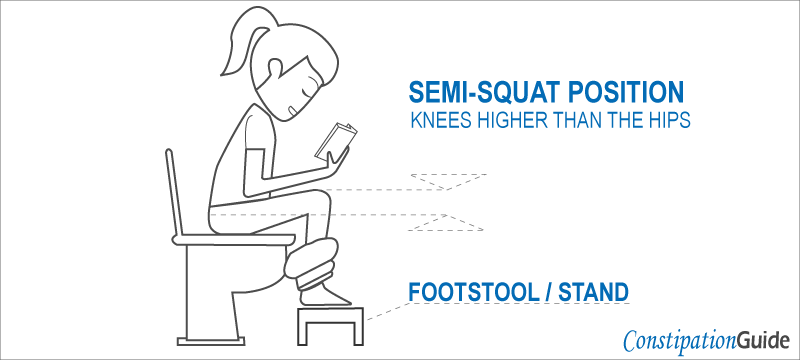
If you suffer from episodic constipation or a severe type, the position you stay on the toilet is essential.
The semi-squat posture relaxes the anal sphincter and creates a clear path through the anorectal canal.
So, what to do when constipated on the toilet in Step 3?
Use a low-rise footstool as follows:
- Put the low-rise footstool near the toilet bowl.
- Make sure it does not move.
- Turn around and put your feet on it.
- Lower your body slowly over the toilet seat.
Squat for 5-10 minutes if you don’t have a low-rise footstool (before you go to the toilet).
In this way, your rectum and puborectalis muscles will relax before you decide to poop.
Which posture is the best?
The “Squat” posture is the best position to use when sitting on the toilet bowl.
Semi-quatting is identical, and it does the same thing. You can practice it on the toilet bowl or off it. These positions keep your knees higher than the hips.
If the modern position of sitting on the toilet works for you, then that’s ok.
But If you suffer from severe or chronic constipation, you should consider buying or creating a footstool.
“The squat movement pattern is required for essential activities of daily living such as sitting, lifting, and most sporting activities.”
Squatting is an excellent position to consider because it improves digestion and motility. It does so by releasing tension in the abdomen and rectum.
Also, it has positive biomechanical and neuromuscular implications on body control, strength, stability, and mobility.
4. SQUEEZE AND EXPAND THE UPPER ABDOMEN
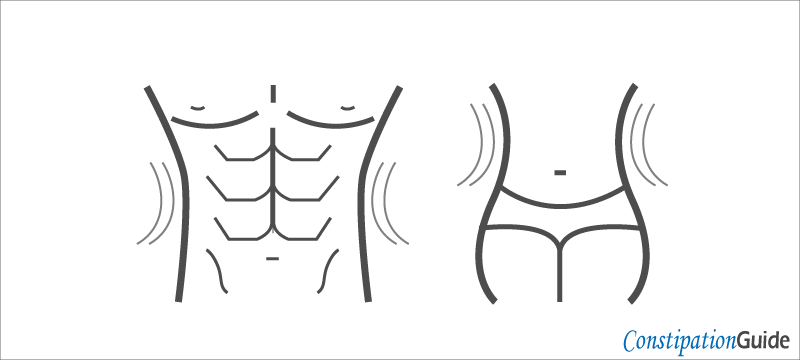
Here is what to do in Step 4.
After you position yourself on the toilet seat, you need to simulate as if you were pooping.
You don't have to stay too long and get stuck on the toilet seat.
You can do this by contracting the muscles in the abdomen and over your belly. Squeeze only the abdomen muscles without the rectum and intestines.
Squeeze the upper abdomen.
Squeeze and push the upper abdomen like this:
- Take a deep breath.
- Keep the air inside.
- Focus your mind on the pectoral muscles.
- Bring the air towards the neck.
Take a deep breath and keep the air inside. Focus your mind on the pectoral muscles. You should feel pressure under the neck.
Contract the muscles and keep them tensed for 5-10 seconds. It is like pushing a heavy object away from your pectoral muscles.
After 10 seconds, release the air and take a short pause.
You can do this contraction without keeping the air inside the lungs. Air increases lung volume. Thus, it makes the intestines move.
Another way is to imagine that you were lifting weights. Imagine it as if you were lying on the ground with your hand up.
Use muscle contraction to move the intestines.
Contraction helps because:
- The intestines will feel the contraction.
- Constant contraction creates movement of the stool.
- Movement creates pressure.
- Intestinal motility is active.
- Pressure and gas make the stool evacuate.
Muscle contraction is beneficial for helping bowel movement.
Also, it will create pressure because of gas in the intestines and their wall movement.
The stool in the intestines makes gas because of fermentation, glucose, and humidity.
Intestinal walls expand and move. And they make the stool to continue its journey towards evacuation.
To have better results with muscle contraction.
Simulate muscle contraction 30 minutes before you go to the toilet.
To have better results, this is what to do when constipated.
Combine muscle contraction with the squat posture to relax the sphincter and puborectalis muscles.
The four steps described above help stimulate bowel movement for most of us.
Good intestinal motility and constipation relief come from practicing these steps.
Consider them as a way of relaxing your body.
Muscle contraction example.
Here is a practical example:
- Contract your abdominal muscles five times per minute.
- Perform this step slowly, repeating it 1-2 times.
- Within 5-10 minutes, you should experience a gentle bowel movement.
- When you sense that the stool is ready to be expelled, lower your body and release it.
Medical experts from The The American College of Gastroenterology state that:
“Constipation can be treated with biofeedback or muscle retraining exercises.”
The health authority recommends relaxing the anorectal muscles and the pelvic floor with muscle movement (as opposed to taking medication).
5. SQUEEZE AND PUSH THE RECTUM WHEN YOU FEEL IT

Here is the most crucial step on what to do when constipated on the toilet.
Push the rectum
Push the intestines and rectum hard when you feel your body is ready to eliminate the stool.
Try to visualize and feel how the matter inside the large intestine moves towards the rectum.
After you relax the puborectalis muscles and sphincter with squatting, the stool will have a clear path toward the rectum.
Repeat this step as follows:
- Slowly push the rectum for 5-10 seconds.
- Take a pause.
- Strain the rectum hard for 1-5 seconds.
- Take a pause.
- Finally, push your rectum hard to evacuate the stool.
Repeat these steps until you feel the stool tickling inside the rectum and anus. When you sense the stool near the anus, put all the pressure on that specific area.
Take deep breaths to fill your lungs with air. After air enters your lungs, keep the air for 5-10 seconds while you try to poop.
After you push the rectum and abdomen, let the air out and relax.
Push and stay calm.
Push the rectum as if you were trying to lift weights and squat simultaneously.
This movement creates pressure in the rectum.
Practice it for 5-10 seconds and pause. Then repeat it. So, the stool will evacuate slowly.
You can take pauses if you feel there isn’t much stool movement. But keep in mind the steps and repeat them slowly.
Don’t push too much because of:
- Pain;
- Cramps;
- Hemorrhoids;
- Gas evacuation;
- Intestinal irritation.
If you feel irritation and pain often, then you suffer from chronic and severe types of constipation.
Pushing, contracting muscles, and putting too much pressure on your abdomen is not a great idea in the long term.
If the symptoms mentioned above appear, try to eat more liquid foods.
Health experts from The World Gastroenterology Organization state that:
“Bowel training can lead to improvement in symptoms, so it should be tried as a first-line treatment.”
“Bowel training includes biofeedback, straining, pelvic floor relaxation, and simulating defecation.”
6. TAKE A PAUSE

To relieve constipation in the long term, here is what to do when constipated on the toilet, with step 6:
- Stand on your feet.
- Go out and take a walk.
- Sit on a couch.
- Stretch your hands slowly.
- Squat with pauses.
Taking pauses is essential to relax your bottom and to keep good blood flow around the abdomen. I
Stress can make you struggle to find relief from constipation while using the toilet.
In this case, you need to address the factors that are affecting you.
Try to take pauses or breaks at least once every two hours.
Before you go to the toilet, take a break and walk for 1-5 minutes to relax your body.
Here is an interesting example. Take a 10-minute pause once every two hours.
Ideally, take a 10-minute pause from work or study every 50 minutes.
OTHER TECHNIQUES
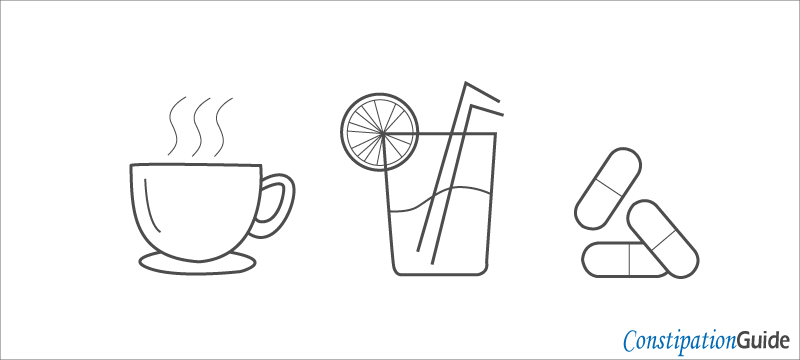
The following techniques help you create pressure inside the intestine and move the stool towards the rectum.
So, here’s what else to do when constipated on the toilet.
Drink hot tea.
Drinking hot tea before going to the toilet will create gas in the intestines.
The heat makes the matter inside ferment or dissolve.
In this way, the matter that stays glued to the intestinal walls can disintegrate.
Gas creates pressure inside the intestines.
The intestines modify their volume. Drink tea only before you want to go to the toilet.
Drink chicory juice
Chicory juice has laxative effects. Chicory is usually a white powder that has a sweet taste.
You can combine it with any liquid juice or just non-carbonated mineral water.
How to use this technique?
- Heat some water.
- Mix the powder in a glass.
- Drink 1-2 glasses of chicory juice.
- Wait 10-15 minutes.
Don’t drink more than two glasses to prevent leaks and excessive fermentation.
Take laxatives
Medicine is beneficial for short episodes of constipation.
Taking too many laxatives is not a great thing to do when constipated on the toilet because it creates dependency.
Laxatives create uncontrolled bowel movements. You need to take the day off.
And have a clean toilet nearby. You need to prepare yourself for 1-6 pooping episodes to evacuate the stool.
If you don’t like laxatives, take bile supplements to improve digestion and stool evacuation.
Take pancreatic supplements
Pancreatic supplements help digestion and stool movements.
These pills do not have side effects. And you can control when you want to have bowel movements.
Pancreatic supplements have an instant effect. They combine the bile with pancreatic juices to improve digestion.
Keep in mind
If you suffer from severe constipation for more than three months, then it is time to see a doctor.
Take blood and stool tests to help you and the doctor establish a diagnosis and treatment.
The advice and the techniques in this guide cannot replace the opinion and the diagnosis of an authorized and specialized doctor.
CONCLUSION
There are many other techniques on what to do when constipated on the toilet.
But they are not as effective as the ones mentioned above.
You can easily use the seven steps presented to poop if you suffer from constipation.
Body preparation and abdominal muscle contraction improve stool evacuation in the long term.
You can combine these steps by taking medicine. Or by drinking certain liquids that create pressure and push the stool to evacuate.
Last medically reviewed on 01.03.2024
